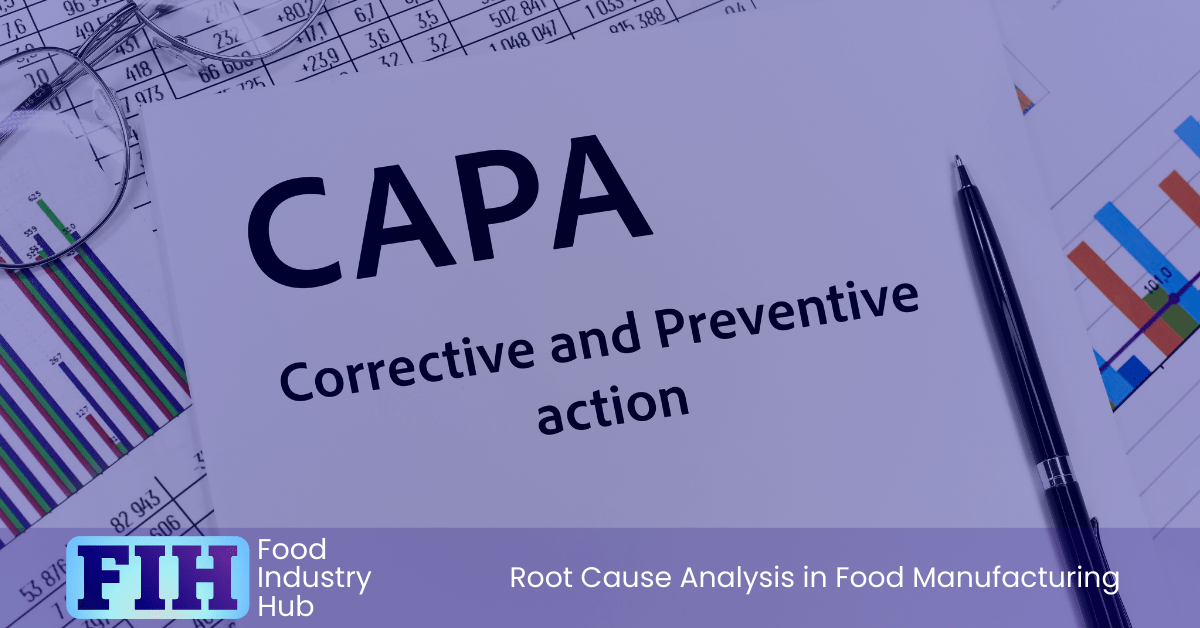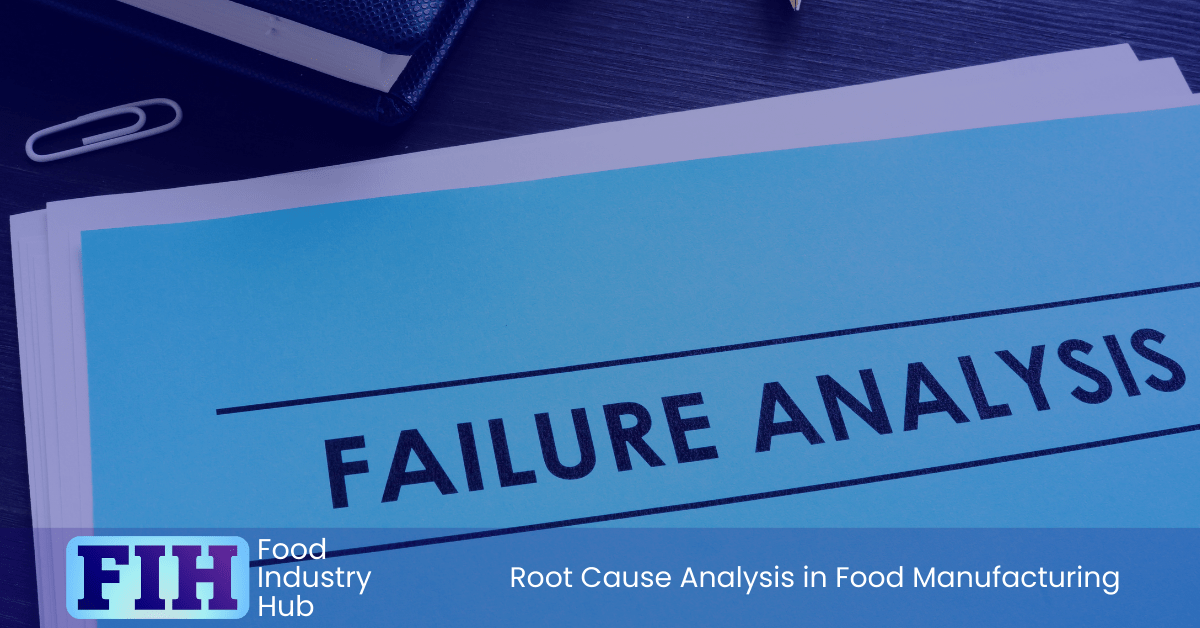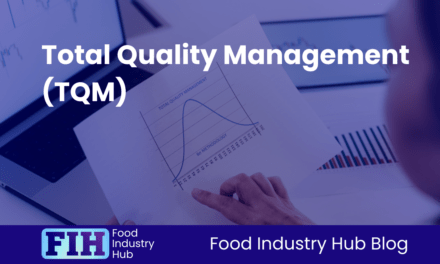Introduction
Imagine you’re a food manufacturer facing recurring product defects. You’re firefighting the symptoms, but what if you could tackle the root of the problem instead? That’s where Root Cause Analysis (RCA) comes into play. It’s a proactive method to identify, address and, importantly, prevent issues from reoccurring. It’s not just about fixing problems, it’s about creating a seamless, efficient operation. Intrigued about how RCA can revolutionise your manufacturing process? Stay with us as we unpack this crucial tool further.
Table of Contents
Key Takeaways
- Root Cause Analysis (RCA) in food manufacturing involves identifying underlying problems causing symptoms like product defects or inefficiencies.
- The RCA process comprises defining the problem, gathering data, identifying possible causes, analysing the root cause, and developing corrective actions.
- Tools used in RCA include the 5 Whys, Fishbone Diagram, Pareto Analysis, Failure Mode and Effects Analysis, and Fault Tree Analysis.
- RCA benefits include improved problem-solving, increased efficiency, risk reduction, enhanced decision-making, and continuous improvement in food manufacturing processes.
- Accurate data collection and analysis, despite potential challenges, is crucial for effective RCA and successful problem resolution in food manufacturing.

Ensure your food safety and quality standards are met with Food Industry Hub Management Systems, an all-in-one digital solution.
Key Concepts in Root Cause Analysis
You’re about to explore key concepts in root cause analysis.
You’ll understand the difference between a symptom and a root cause, learn about causal relationships, and discover why prevention is more beneficial than just correction.
It’s all about pinpointing problems at their origin to ensure they don’t recur.
Symptom vs. Root Cause
In food manufacturing, understanding the difference between a symptom and the root cause is very significant. These two terms, while often used interchangeably, hold very different meanings in root cause analysis.
A symptom is merely a sign, an indication of something that’s gone wrong. It’s what you see on the surface. For instance, if a batch of cookies comes out of the oven burnt, the burnt cookies are a symptom. It’s easy to spot, but it doesn’t tell you why the problem occurred.
On the other hand, the root cause is the underlying reason that led to the symptom. It’s what’s lurking beneath the surface. If we take the burnt cookies example, the root cause could be a faulty oven sensor, an error in the baking time, or perhaps a mistake in the recipe itself.
When you’re dealing with a problem, don’t just focus on the symptoms. Dig deeper. It’s crucial to identify and address the root cause. By doing so, you’re not just fixing the current issue, but you’re also preventing future ones.
Causal Relationships
Ever wondered how one minor oversight in the food manufacturing process can trigger a chain of events leading to a significant issue? That’s where understanding causal relationships comes in.
Understanding causal relationships can help you comprehend how different elements in the manufacturing process interlink and influence each other. It’s like piecing together a complex puzzle, where each component, no matter how small, has a role to play.
One error, like a temperature fluctuation in a cooking process, can have a knock-on effect, leading to non-conforming product, waste, and potentially even recalls.
But it’s not just about identifying these relationships. It’s also crucial to understand the depth and breadth of these connections. How strong is the link? How many steps are there in the chain of events? Are there multiple, interconnected causes?
Prevention, Not Just Correction
Understanding and identifying causal relationships in food manufacturing is only the first step. The ultimate objective is prevention, not just correction. In other words, it’s about stopping problems before they even start.
You see, root cause analysis isn’t just about finding out what went wrong. It’s also about figuring out how to prevent the same thing from happening again. That’s why it’s so important to focus on prevention, not just correction.
When you’re carrying out root cause analysis, you shouldn’t just be looking for the cause of a problem. You should also be looking for ways to prevent it. By doing this, you’re not only solving the current problem but also preventing future problems.

RCA Process Steps
Now, let’s walk through the RCA process steps.
First, you’ll need to define the problem, then gather the necessary data.
Afterwards, you’ll identify possible causes, analyse the root cause and finally, develop corrective actions.
Define the Problem
Identifying the problem is your initial step in the RCA process. As a food manufacturer, you’re likely to encounter a myriad of issues, ranging from quality defects to operational inefficiencies. The way you approach these will depend heavily on how the original problem is framed or presented. So, ‘defining the problem’ extends beyond acknowledging the occurrence of a fault and significantly influences the rest of the process.
To illustrate, think about the following problem statements and how they might shape the subsequent root cause analysis:
• A piece of equipment malfunctioned.
• The conveyor belt at the in feed of oven 3 stopped running so product could not be loaded into the oven.
• The conveyor belt at the in feed of oven 3 stopped running for the sixth time in two weeks.
• When there are mechanical issues on line 3, there is often a delay of up to two hours before an engineer becomes available to fix the equipment.
In each of the above cases, the definition of the problem is slightly different – even though the circumstances and presentation of fault may be identical.
When beginning a root cause analysis, defining the problem correctly might require some critical thinking as to whether a reported fault represents an underlying issue, is symptomatic of a problem, or forms part of a trend which is itself indicative of a problem.
Gather Data
Once you’ve clearly identified and articulated the problem, the next step is to gather data. This step is crucial in the Root Cause Analysis (RCA) process, particularly in the food manufacturing industry.
It’s not just about collecting information randomly—you need to gather relevant, accurate, and comprehensive data to understand the depth and breadth of the issue.
You might be wondering where to start. Well, data can come from various sources such as quality control records, equipment logbooks, production schedules, customer complaint records, internal nonconformance trending, and simply by talking to operators and managers for the relevant processes.
Remember, you’re not just looking for data that directly relates to the problem. You’re also interested in information that gives the context of the problem like environmental conditions, operational changes, or new personnel.
While gathering data, it’s important to keep an open mind. Don’t jump to conclusions or make assumptions. You’re laying the groundwork for discovering the root cause, so ensure the data you collect is unbiased and factual.
Data gathering should be exploratory rather than confirmational. In other words, you should try to gather data in an open-minded way That enables information about the problem and possible causes to emerge, rather than making assumptions and gathering data that supports those initial leanings.
Stick to the facts, and don’t let personal opinions or hunches steer your data collection. You’ll need a solid foundation of information to correctly identify possible causes in the next step.
Identify Possible Causes
With your data at hand, it’s time to dive into the possible causes of the problem. This step in the root cause analysis (RCA) process is all about brainstorming and being thorough.
Don’t rush it; every possible cause should be considered, no matter how small it might seem.
Start by looking at your data. What patterns emerge? Are there inconsistencies in the production process, equipment failure, or human error? Once you’ve identified these patterns, you can start making a list of potential contributing factors that resulted in the manifestation of the problem.
Remember, you’re not looking for the definitive cause just yet. You’re compiling a list of possibilities.
Don’t discount anything at this stage. Even the most unlikely cause could turn out to be significant.
Analyse the Root Cause
Now, you have a comprehensive list of potential causes/contributing factors. Your next step? Dive deeper and analyse these to identify the root cause. It’s not about pointing fingers or laying blame; it’s about understanding what’s really going on beneath the surface.
Remember, you’re looking for the cause that, if eliminated, would prevent the problem from occurring. It’s not enough to find a cause that merely contributes to the problem.
Whatever problem is identified at the onset of the root cause analysis May have had one or more immediate/proximal causes. Often, those proximal causes are merely symptomatic of deeper systematic issues – which could be expressed in a variety of ways. This is why it’s important to correctly identify the nature of the problem, the immediate circumstances (causes/contributing factors) that led to the problem, and any weaknesses in the quality management system that made it possible for the problem to emerge.
It’s helpful to hold in mind the question ‘what assurance system or control measure should have prevented this problem from occurring, and how is it possible for that system to have failed?’.
Alternatively, you can think about an identified problem as falling within the remit of one or more control systems – So ask questions like…
• Should this problem have been prevented by a prerequisite programme? If so, does the root causes lie in the adequacy of the prerequisite programme?
• Should this problem have been prevented by a management process? If so, does the root cause lie in the adequacy of a procedure, compliance with instructions, or training?
This type of inquiry into the root cause steers the investigation from immediate approximal contributing factors toward the root cause.
Develop Corrective/Preventative Actions
After identifying the root cause, it’s your job to develop effective remedial actions that will prevent the issue from reoccurring. Corrective actions are solutions formulated to directly address the problem, while preventative actions are intended to work on the root cause to prevent the same problem from happening again.
First, brainstorm a list of potential corrective actions. Consider the resources available, the practicality of the solution, and the impact it can have on the problem. Be sure this list is comprehensive, considering all possible solutions.
Next, evaluate and rank these solutions. You’ll want to select the most effective.
Think about the corrective and preventative actions available to you, and whether it would be feasible for the root cause of the problem to exist after the implementation of these actions. Highly effective preventative actions would make it inconceivable for the same loss of control to emerge after their implementation.
Once you’ve chosen the most promising corrective actions, it’s time to create a detailed action plan. Identify the steps necessary to implement the solution, who’ll be responsible for each step, and when each step should be completed.
Implement and Monitor
Have it’s helpful to think about corrective and preventative action plans as falling into the Deming cycle (plan do check act).
If the root cause analysis as add identified a range of distinct contributing factors pointing to a root cause for the emergent problem, the corrective and preventative action plan should ideally include remedial actions to address all of the contributing factors as well as the root cause.
It’s a sector wide convention to refer to ‘the root cause’ as a singular – Which is helpful in that it places a focus on root cause over proximal causes… but potentially misleading in that it implies that there will be only one root cause. In fact, the outcome of the root cause analysis will often be layered – with numerous proximal contributing factors and one or more root causes that enabled those contributors.
The corrective and preventative action plan should include remedial actions to resolve the problem as it originally presented, correct for any proximal causes and associated risks, and eliminate the underlying root cause(s) so as to prevent the problem from recurring.
Distinct actions may be undertaken by different individuals within your team. This might be a reflection of department, function, or area of ownership. There may be different time scales for implementation depending on importance/severity, resource requirements, and practical constraints The limit the speed of implementation.
Following the plan do check act protocol, the effectiveness of any remedial actions should be verified After their implementation – with appropriate course correction where necessary.

Common Tools Used in RCA
Now, let’s turn our attention to the common tools you’ll use in RCA.
These includes the 5 Whys, the Fishbone Diagram (also known as the Ishikawa Diagram), the Pareto Analysis, the Failure Mode and Effects Analysis (FMEA), and the Fault Tree Analysis (FTA).
You’ll find each of these tools invaluable in identifying, understanding, and addressing the root causes of problems in food manufacturing.
5 Whys
The ‘5 Whys’ is a common RCA tool you can use. You start with the end problem and ask ‘why’ five times, or until you reach the root cause. It’s simple, but it’s also powerful. It forces you to look past symptoms and uncover the underlying issues.
The ‘Whys’ are the series of questions you ask to drill down into the root cause of a problem. They’re the key to unlocking what went wrong and how to prevent it from happening again.
• Start out with the statement of the problem, and ask why did the problem occur? Whatever the answer to that question (the first ‘why’) is can be taken as approximal cause or contributing factor that resulted in the manifestation of the problem.
• Next, ask why that contributing factor was allowed to take effect – So why did the contributing factor that allowed for the emergence of the problem exist?
• Continue to ask ‘why’ for every proximal cause yielded by the investigation Until it is impossible to go back any further and the ultimate root cause is identified.
For instance, if a food product is spoiling prematurely, you don’t stop at ‘the refrigeration unit failed’. You ask, ‘why did the unit fail?’ and ‘why wasn’t it noticed?’ until you’ve identified the root cause.
Don’t be afraid to ask ‘why’ more or fewer times as needed. The number isn’t set in stone. What’s important is that you’re thorough, and you don’t stop until you’ve found the root cause.
That’s how you’ll prevent the issue from recurring, saving time, money, and potential damage to your reputation.
Fishbone Diagram (Ishikawa Diagram)
Your toolkit for Root Cause Analysis isn’t complete without the Fishbone Diagram, also known as the Ishikawa Diagram. This powerful tool helps you identify, explore, and graphically display all potential causes related to a problem or condition.
Imagine a fishbone’s structure. At the head, you’ve got your problem or condition. The spine represents the ‘root cause,’ and the ribs are potential contributing factors. You’ll sort these contributing factors into categories, often based on the 6Ms: Man (People), Method (Processes), Machine (Equipment), Materials, Measurements, and Mother Nature (Environment). This helps organise your thoughts and stimulate brainstorming.
In a food manufacturing context, let’s say you’re experiencing a drop in product quality. You’d place this at the head of your fishbone. Then, explore each category for potential causes. Perhaps manpower is an issue due to insufficient training. Maybe the machines are obsolete, or the materials could be subpar.
The Fishbone Diagram doesn’t just list potential causes; it also shows their relationships, which allows you to identify areas of focus. Remember, the aim isn’t to assign blame, but to uncover the root cause and improve your processes.
Pareto Analysis
Eighty percent of your problems could be stemming from just twenty percent of the causes, according to the Pareto Principle. This principle is the backbone of Pareto Analysis, a tool you’ll find invaluable in Root Cause Analysis (RCA).
Pareto Analysis helps you identify, prioritise, and tackle the causes that have the most significant impact on your problem. It’s a simple yet powerful technique. You start by listing the causes of a problem, then assign a score to each based on its severity or frequency.
Next, you’ll create a Pareto chart, a type of bar graph where causes are plotted in descending order of their scores. The leftmost bars represent the most critical causes – your ‘vital few’.
Focusing on these ‘vital few’ can lead to significant improvements. They’re what you need to tackle to see the biggest reduction in the problem.
But remember, Pareto Analysis isn’t a standalone tool. It’s most effective when used with other RCA tools, as each provides unique insights. So, don’t stop here. Keep exploring and combining tools to get to the root of your problems.
Failure Mode and Effects Analysis (FMEA)
Failure Mode and Effects Analysis (FMEA) is another powerful tool you can’t afford to overlook. This systematic approach helps you identify potential failures in your processes before they happen.
It’s all about being proactive, not reactive, which is key to ensuring the safety and quality of your products.
Imagine you’re making a batch of cookies. FMEA would have you list all the things that could possibly go wrong – from ingredients being mixed incorrectly to the oven temperature being too high.
You’d then rate each potential failure based on three factors: severity, occurrence, and detection. The end result? A risk priority number that tells you what needs your attention first.
But it doesn’t stop there. Once you’ve identified and prioritised your potential failures, you then develop actions to prevent them or reduce their impact.
You’re not just finding problems – you’re solving them.
Fault Tree Analysis (FTA)
Moving on from FMEA, let’s explore another instrumental tool in Root Cause Analysis – Fault Tree Analysis (FTA). FTA is a top-down, deductive approach used in identifying potential problems and their causes.
It’s a visual tool that helps you understand the interrelationships among failures in a system. You start with a top event – the failure you’re trying to prevent. Then, you work your way down, identifying all the possible causes of that failure.
Imagine it as a tree, with the top event as the trunk, and the potential causes as branches. Each branch can further divide into smaller branches, representing more specific causes.
FTA is particularly useful in the food manufacturing industry. You can use it to identify potential areas of failure in your processes, from ingredient sourcing to final product delivery.
It can help you pinpoint where a contamination might occur, or where a process might break down, leading to product spoilage.
It’s a proactive tool, enabling you to identify and address potential failures before they occur. Remember, it’s always better to prevent a problem than to fix it after it’s happened.

Sign-up for the Food Industry Hub Mail Service
We regularly produce new content for food industry professionals, and the Food Industry Hub Mail Service is the best way to stay up to date with the latest additions.
Signup today to be added to the Food Industry Hub mailing list.
Benefits of Root Cause Analysis
You might be wondering, “What’s in it for me?” when it comes to Root Cause Analysis (RCA).
Well, RCA can significantly improve your problem-solving skills, increase efficiency in your operations, and reduce risks associated with food production.
Plus, it can greatly enhance your decision-making process and promote continuous improvement in your business.
Improved Problem-Solving
With the implementation of root cause analysis in food manufacturing, your problem-solving skills are likely to see a significant improvement.
It’s not just about finding quick fixes but resolving issues at their source. This method encourages you to dig deeper, to uncover the ‘why’ behind the problem. You’ll move beyond treating symptoms and start tackling the disease.
Root cause analysis prompts you to investigate. Was it an issue with materials? Equipment? Human error? You’ll probe until you find the root cause.
This approach to problem-solving does more than rectify immediate issues. It stimulates a culture of curiosity and continuous improvement.
You’ll start asking the right questions, identifying patterns, and preventing future mishaps. It’s about transforming reactive measures into proactive strategies.
Increased Efficiency
Embracing root cause analysis can lead to a substantial increase in efficiency within your food manufacturing processes.
Efficiency isn’t just about speed; it’s about making the most of your resources. By identifying and addressing the root cause of a problem, you’re not just putting a band-aid on a symptom, you’re eliminating the source. This means less time spent troubleshooting, and more time dedicated to profitable operations.
Consider the resources spent on recurring issues. Manpower, materials, time – these costs add up. But when you solve a problem at its root, you cut these unnecessary expenses. Efficiency soars as waste plummets.
It’s not just about cost savings, though. Root cause analysis also improves the quality of your output. By fixing core issues, you reduce the chance of defects and ensure a more consistent product. This in turn boosts your reputation for reliability, leading to increased customer satisfaction and potentially higher sales.
In short, root cause analysis streamlines your operations. It’s a proactive approach that promotes efficiency, reduces waste, and enhances product quality.
And in the competitive world of food manufacturing, that advantage can make all the difference.
Risk Reduction
Root cause analysis serves as a powerful tool for risk reduction. By identifying the underlying causes of problems, you’re able to proactively address them, thereby reducing the likelihood of their recurrence. You’re not just putting a band-aid on a problem; you’re solving it at its source.
Imagine a scenario where a batch of product has been recalled due to a contamination issue. Without root cause analysis, you’d likely just clean up, make another batch, and hope for the best. But with it, you’d dig deeper. You’d investigate where the contamination originated, why it wasn’t detected earlier, and how your processes can be improved to prevent it from happening again.
In this way, root cause analysis helps you to minimise risks and foster a safer, more reliable production environment. It’s not just about fixing problems as they arise; it’s about preventing them from happening in the first place.
And in an industry where safety and quality are paramount, that’s a benefit you can’t afford to ignore. So, embrace root cause analysis, and take a proactive step towards risk reduction.
Enhanced Decision-Making
Your company’s decision-making processes can be dramatically improved through the use of root cause analysis. By identifying and understanding the underlying causes of problems, you gain valuable insights that enhance your decision-making capabilities.
It’s not just about fixing issues as they surface, it’s about digging deeper to understand why they arose in the first place.
Imagine you’re dealing with recurring equipment malfunctions in your food processing line. Instead of merely addressing the immediate issues, conducting a root cause analysis allows you to pinpoint the actual source of the problem. This might be poor maintenance practices, outdated equipment, or even inadequate staff training.
With this information, you’re better equipped to make informed decisions, whether it’s investing in new machinery or enhancing employee training programs.
Root cause analysis helps you anticipate potential challenges. As you delve into issues, you’ll likely identify patterns or trends that could lead to future problems.
Armed with this foresight, you can make proactive decisions that prevent such issues from surfacing, saving your company valuable time, resources, and potentially, your reputation.
Ultimately, root cause analysis is a powerful tool that can transform your decision-making process, making your business more efficient and effective.
Continuous Improvement
Root cause analysis paves the way for continuous improvement in your food manufacturing business. It’s like a compass, guiding you towards the pinpointed issues that need your attention. By identifying the root causes of problems, you’re able to make targeted changes that can significantly improve your processes and product quality.
Imagine not having to deal with the same issue repeatedly because you’ve resolved it from its core. That’s what root cause analysis offers. It eliminates the guesswork and provides clear, actionable insights.
This methodology encourages a proactive mindset. You’re not just waiting for problems to surface, you’re actively seeking potential issues and addressing them before they escalate. This can save you time, money, and resources in the long run.
Moreover, continuous improvement fuels innovation. As you refine your processes and solve root causes, you’re also opening doors for new ideas and strategies. This can lead to increased productivity, better product quality, and a competitive edge in the market.
In the end, root cause analysis isn’t just about solving problems. It’s about fostering a culture of constant improvement and innovation.

Challenges in Root Cause Analysis
While root cause analysis can significantly enhance your food manufacturing processes, it’s not without its challenges.
You might grapple with incomplete data, a process that’s time and resource intensive, and even resistance to change within your organisation.
There’s also a risk of focusing too much on symptoms rather than the actual root causes.
Incomplete Data
One major stumbling block you’ll often encounter is incomplete data. This hitch can significantly impede your ability to pinpoint the exact cause of a problem. Without all the necessary data, you’re essentially attempting to solve a puzzle with missing pieces.
Not having full access to data might stem from various reasons. It could be due to insufficient data collection practices, miscommunication between departments, or employees’ lack of training in data recording.
To combat this, it’s prudent to regularly review and update your data collection and management practices. It’s imperative that everyone involved understands the importance of accurate, complete data.
Training programs can help familiarise your team with best practices and the potential consequences of incomplete data.
Time and Resource Intensive
Another significant challenge you might face in root cause analysis is its time-consuming and resource-intensive nature. This isn’t a process that can be rushed or skimped on. It demands a considerable investment of both time and resources to be effective.
You might need to dedicate hours, if not days, to thoroughly investigating and determining the root cause. It’s not as simple as finding a quick fix. Instead, it’s about delving deep into the problem, peeling back layers to reveal the true cause. This takes time and requires a meticulous approach.
In terms of resources, you’ll need personnel who are trained in root cause analysis techniques. It’s not something that can be handled by just anyone. You’ll also need to allocate funds for any necessary equipment or tools. This could range from diagnostic software to testing materials.
The process doesn’t end once you’ve found the root cause. You’ll then need to develop and implement a solution, which is another time and resource commitment.
Despite these challenges, it’s important to remember that root cause analysis is a crucial step in improving your food manufacturing processes. It may be difficult, but it’s a necessary investment for long-term success.
Resistance to Change
Often, one of the biggest challenges you’ll face in root cause analysis is resistance to change. It’s human nature to resist what we don’t understand or find uncomfortable, and changes in processes or procedures can certainly fall into this category.
You’re not alone if you’ve faced a workforce that’s reluctant to embrace new ways of doing things.
Resistance to change can manifest in many ways. It can be as subtle as a lack of engagement or as blatant as outright refusal to follow new procedures. Whatever form it takes, it’s a hurdle that needs to be overcome for successful root cause analysis.
You can tackle this issue head-on by ensuring clear communication about the reasons for change and the benefits it brings. Training, reassurance, and patience are key. Remember, change is a process, not an event.
Involving your team in the root cause analysis can also help. When people feel part of the solution, they’re more likely to embrace the necessary changes.
Despite the challenges, overcoming resistance to change is critical to achieving the full benefits of root cause analysis in food manufacturing.
Focusing on Symptoms
While it’s essential to address immediate problems, you should be careful not to focus solely on the symptoms during your root cause analysis.
It’s a common pitfall in food manufacturing, where pressure to maintain production levels can overshadow the need for thorough investigation. It’s like treating a fever without identifying the infection causing it.
In your quest for quick solutions, you may overlook the deeper, systemic issues that lead to recurring problems. This doesn’t mean you shouldn’t fix the immediate issues. Instead, it’s a call to take a step back, look beyond the surface, and dig deeper.
Consider a scenario in which a machine frequently breaks down. You could continuously repair it, but the breakdowns might still persist. The root cause could be anything from improper maintenance schedules to operator errors.
The challenge here is to balance immediate problem-solving with long-term, sustainable solutions. This requires an open mind, careful observation, and the patience to uncover the real root cause.
Ultimately, focusing on symptoms rather than root causes is a short-term fix that can lead to long-term headaches. So, don’t just treat the symptoms, cure the disease.

In Summary
So, you see, RCA is a game-changer in food manufacturing. By identifying and addressing the root causes, not just the symptoms, you can drastically improve your operations. Using tools like the 5 Whys and Fishbone Diagrams, you’ll streamline processes, enhance product quality, and reduce food safety risks. Sure, there may be challenges, but the benefits of fostering a culture of continuous improvement are worth it. Take the leap, implement RCA, and see the difference it makes.

Further Resources
Food Industry Hub serves the food industry with a range of digital resources for the benefit of both commercial food manufacturers and food industry professionals.
For food manufacturers, we offer integrated management systems that give every user a direct interface with your QMS.
For food industry professionals, we provide an extensive signposting service in addition to informational content we hope you’ll find useful as you face new professional challenges. We have very ambitious plans to expand the range of services offered, and currently present informational content on management, safety and quality, food safety and quality culture, and professional success.














